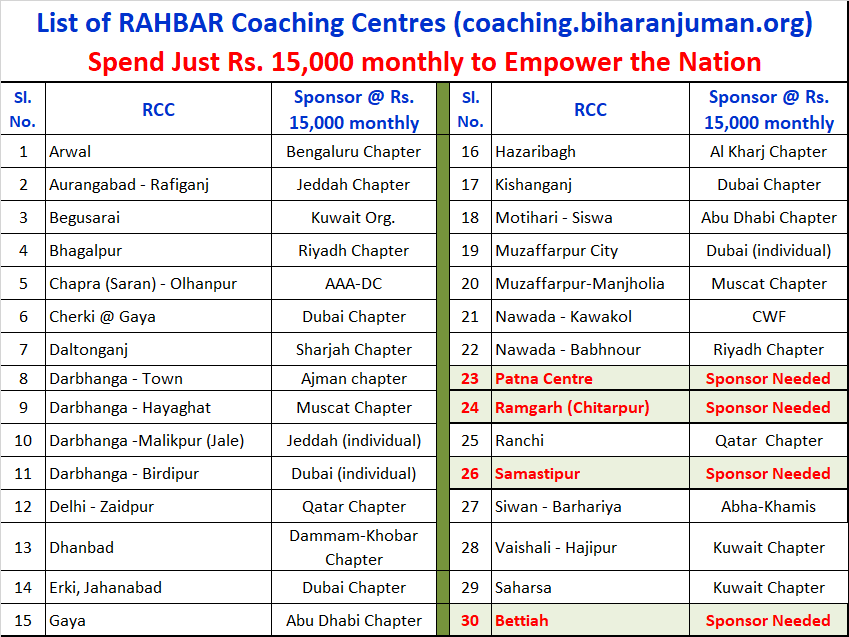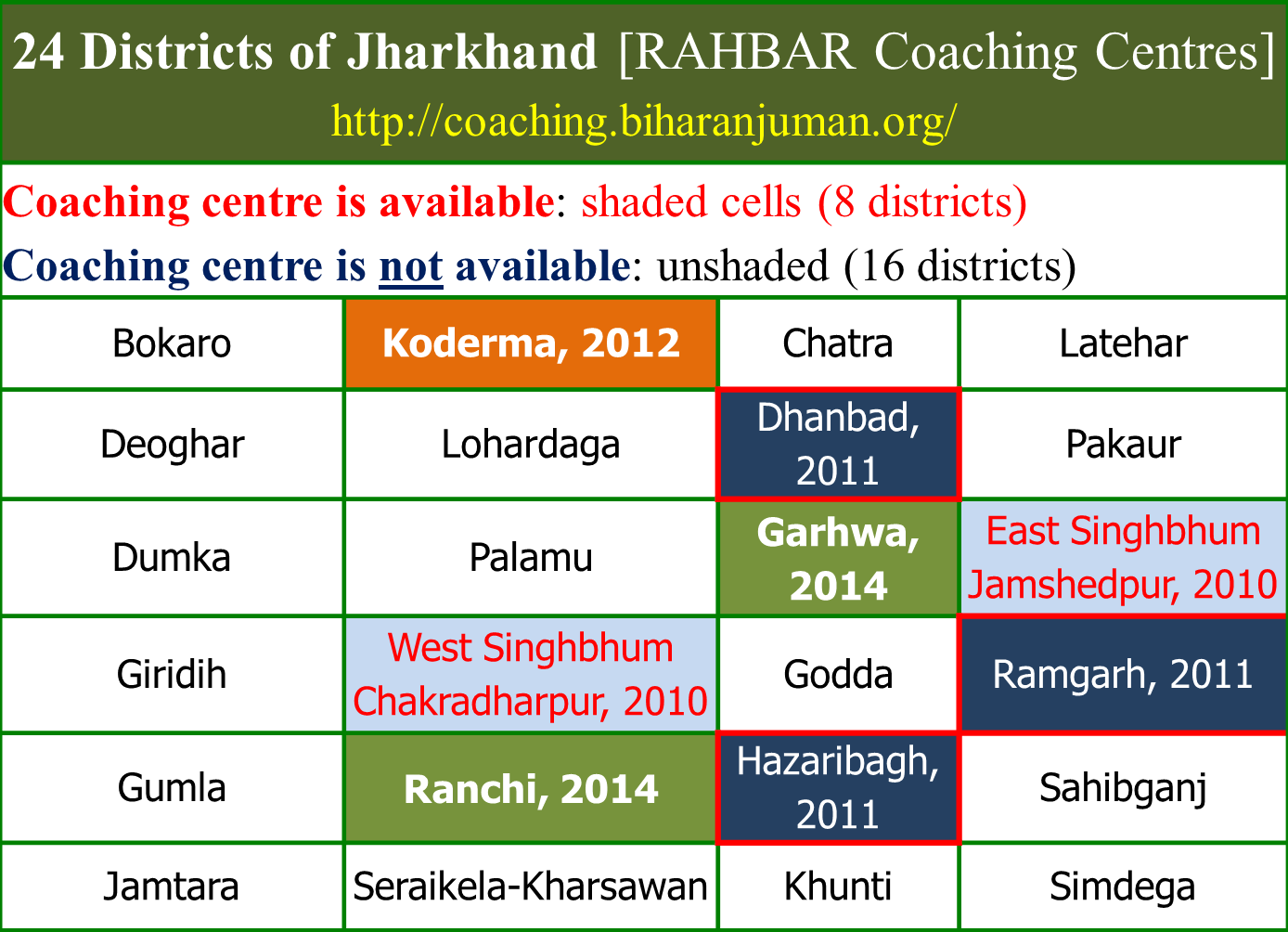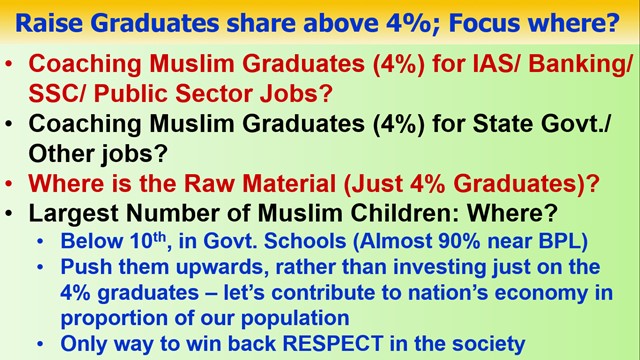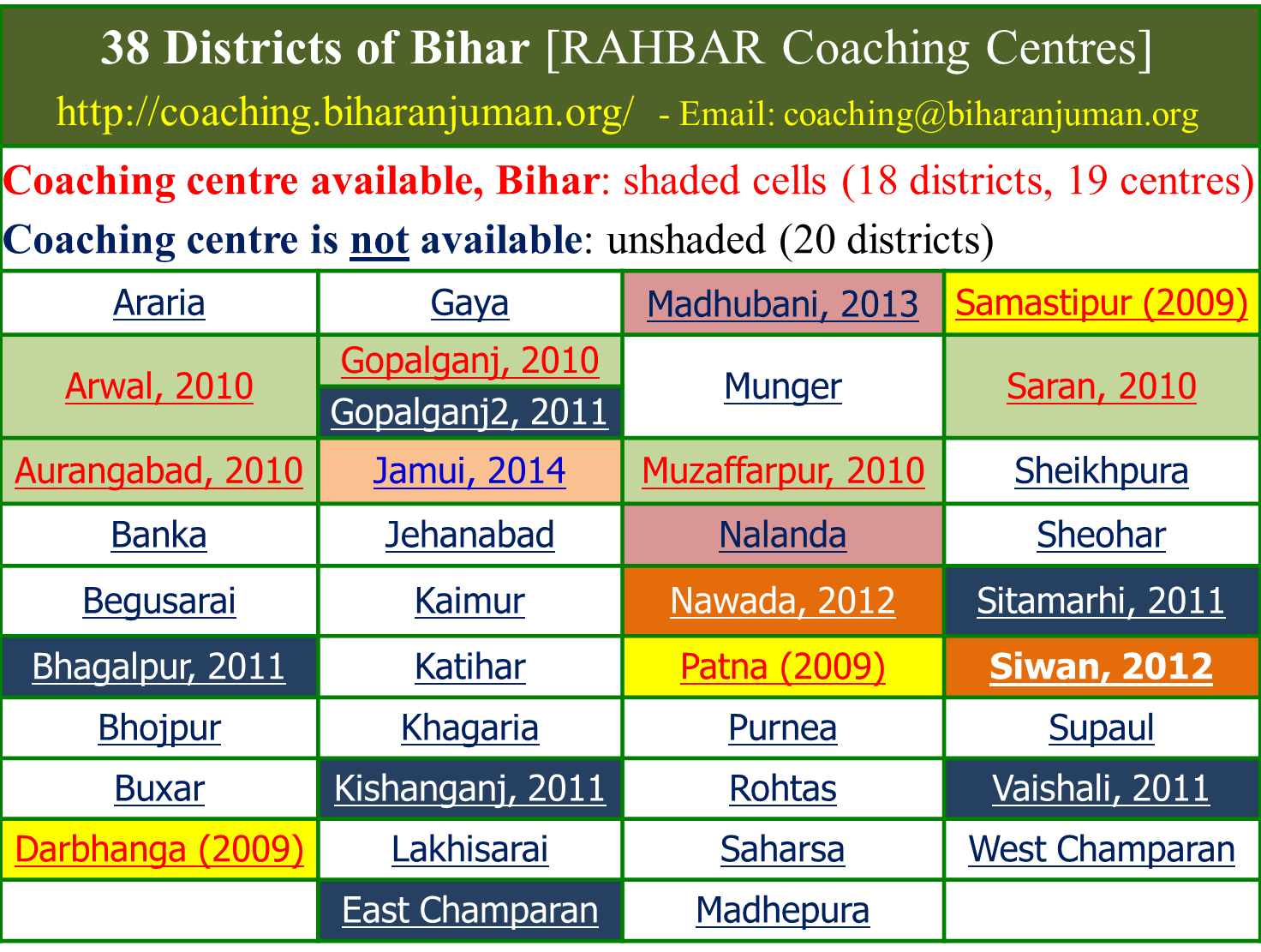Coaching of School Students to minimize drop-out & Raise Percentage of Weakest Economic Class Students in Colleges and Universities
Coaching to stop school drop-outs || Madrasa-cum-school
for Girls ||
ITI
College




Commit your contribution: fill-up online form (click here), or send email to coaching@biharanjuman.org[Subject: "Commitment to Sponsor RAHBAR Scholarship"] |

Vision : Educational empowerment of deprived sections of the society.
Mission: Provide at least one centre of coaching in every district of Bihar and Jharkhand
Commit your contribution, by filling-up a simple online form (click here) or by sending email to coaching@biharanjuman.org [Subject Line: "Donation for RAHBAR Coaching Projects"] |
Primary Objective :
The primary objective is to stop the dropping-out of school students, which is at an alarming level in the minority and other Dalit communities.
Shikwa-e-zulmat-e-shab se to kahin behtar tha;
Apne hissey ki koi shamm'a jalaate jaatey. [Ahmad Faraz]
|
Better light a candle than curse the darkness |
|
Detailed Objectives:
Minimize the level of drop-out among the school-going students of the minority community and other Dalit communities, gradually, to a zero-level, within ten years of launching this
project. This is expected to inspire the large percentage of boys and girls to go to school and madarsas rather than sit at home or engage in menial work. As per Sachar Report, more than 50% of the Muslim boys and girls in rural areas and more than 60% of those in urban areas
neither go to schools nor to madarsas. The situation is better among Dalits of the majority community. Twenty-five percent (25%) of Muslim children in the 6-14 years age group have either
never attended school or have dropped out. Drop out rates among Muslims are higher at the level of primary, middle, and higher secondary. In premier colleges, only one out of twenty-five
(4%) under-graduate students and one out of fifty post- graduate (2%) students are Muslims. How can we demand more than 4% jobs in any sector?
National Sample Survey Organisation (NSSO), a central government body, confirmed on 19th May 2010, that Muslims remain the most backward community on the educational front. Muslims’ ratio in higher education is lower than even Scheduled Tribes (STs), considered most backward. Out of every 100 Muslim in the education system, just 10 are enrolled in high school and above. Similar ratio for STs is 11, for SCs 12 and for OBCs, it is 14. How can we compete with the majority community or the Christian minority community, unless we push more of students to secondary or higher secondary levels?
The main reason for high dropout level is poverty (24%), and lack of community support (culture). Parents fear that their wards may ultimately have to dropout, because of (a) poor academic performance, and (b) lack of financial support. The immediate loss of earnings that their wards may currently be bringing may be a great driving force. Some experiments by themselves or by those they know might have resulted in their wards' failure in terminal or yearly exams. This validation of their fear adds to the perception that it is worthless wasting the time of their wards in educational pursuits.
Since, more than 80% of school-going age of our population is not able to reach the 10th level, we need to intervene @ lower garde levels.
The objective, therefore, is to engage the
wards of the poor (sections that cannot afford private tuitions)
(a) school-going students in part-time quality coaching, so as to improve their academic performance,
(b)
boost their confidence levels, and raise their hope for making-it-big-someday.
(c) non-school-going boys and girls in efforts to make them literate, so that they could be sent to
some school, soon.
The ultimate objective is to attain 100% literacy, for all the communities, and bring the deprived sections of the communities at par with the priviledged sections.
Districts to be covered [Geographical Coverage]:
All localities dominated by the minority community, in all districts of Bihar and Jharkhand, starting with a 1st phase of this project in seven districts - first 7 that become ready through the efforts of local and online community.
With an aim to have at least one centre in every district of Bihar & Jharkhand, the 2nd phase of 7 centres would be taken up after the first 7 becomes operational. Simialrly, the 3rd phase of 7 centres would be taken up when 14 centres become operational. And, so on ...Total number of districts: 62 (38 in Bihar, and 24 in Jharkhand) >> We need to establish 62 coaching centres.
Curriculum to be covered, in the project : State Board
State Board
Grades of students to be coached, in the pilot project :
Stage-1: Grades 8, 9 and 10, to start with. Government support may be utilized to make the non-school-going children literate.
The number of students, at each of the centres will be 60. They would include boys and girls, and non-Muslim students from the economically weaker sections would also be taken
in, but priority would be given to the minorities.
Future Stage-2: With increasing awareness among the local populace, and support from various organizations, the classes to be expanded downstream (towards grades 7,6, 5 etc). This is with an intention to increase the enrollment percentage of students @ grade 8 level (hardly 30% of the Muslim children reach this stage).
Future Stage-3: Expand upstream, i.e., include 11th and 12th so as to prepare the students for diploma or engineering entrance exams. This is proposed as the last stage because, post secondary levels have hardly 10% enrollment. Once the percentage increases by intervention at stage-1 and stage-2 levels, it would be wise to groom this level as well. Currently, numerous coaching facilities take care of the 10% that happen to reach this leve. Also, at 10th grade, opportunities open up for admission into ITI course to become technicians, thus become an earning member of the family.
Timing of classes:
After-school hours, which may be different in different locations depending on the availability of power-supply. Some centres may even go for pre-school hours.
Fees to be charged to students : NIL
The tuition is absolutely free to students. They are to be drawn from the families that are not in a position to pay for their education – All of them would be going to government schools or madarsas.
Other Partners in the project:
1. Bihar Anjuman, www.biharanjuman.org, its various chapters around the world and in India through its yahoogroup http://groups.yahoo.com/group/biharanjuman/ with more than 12,000
members.
2. TheAligarhForum, and its affiliates,
3. Imarat Sharia, Patna, http://www.imaratshariah.org/
4. Qaumi Tanzeem, most popular Urdu daily of Bihar and
Jharkhand
5. Bazme Adab, an organization managed by students of MIT, Muzaffarpur, assisted by Bihar Anjuman
6. Najm High School, Patna
7. RAHBAR-Aligarh, a chapter of
Bihar Anjuman, headed by Dr. Mubarak Hussain Sb, senior faculty of JNMC.
8. Any organization that is ready to cooperate or collaborate, either at the local level or at national or international level.
Level of involvement of Partner organizations:
Provision of infrastructure and related facilities (e.g., the madarsas and school quoted above), financial support (e.g., Bihar Anjuman), logistical support and guidance (e.g., Bihar Anjuman and Imarat Sharia), media support (Imarat Sharia and Qaumi Tanzeem).
Immediate Requirements:
1. Each centre will have 3 teachers [one each of Science, Maths, and English], to start with. It is proposed to appoint teachers to teach part-time, to start with. The strength
should increase to 6 ultimately.
2. Infrastructure – class-rooms with minimum teaching facilities. The pilot project will utilize existing facilities, for free.
3.
Books, notebooks, stationery material, for each student. Textbooks should already be available with school-going children. If not available, it will have to be provided.
4.
Transport to bring students (possibly teachers, also) from areas that are a little far off from the coaching centres.
5. Communications: use of telephone to update the project
in-charge, use of net cafes or courier services, etc.
6. Weekly, monthly, annual prize to best-performing students to motivate them.
7. Some financial support to the parents
of really poor students … not to be taken up initially, but will be part of a long-term plan. This should compensate the parents for the loss from their wards not earning for them.
Immediate Financial Requirements:
Most of the financial requirements will cover the above immediate requirements. A tentative assessment is presented below, as per discussion with some associates:
1. Teachers: Rs. 4,000 per month for part-time services of 3 hours per day [Rs. 3,000 for 2 hours per day]. The monthly expenses on 3 budgeted
teachers is between Rs. 9,000 (for 2 hours of coaching classes everyday) and Rs. 12,000 (for 3 hours of coaching classes everyday).
2. Other Monthly
expenses have been budgeted as Rs. 3,000 per month. Some monthly expenses may be earmarked for awards (we have prescribed Rs. 1,200 as minimum awards to 18 students every month
under 3 categories) to best performing students, for stationery requirements of assessment tests, or for maintaining hygiene in the premises and for promoting hygiene among the students,
etc.
3. Annual expenses on books, etc: Rs. 300 per student, which means Rs. 18,000 per year for budgeted batch of 60 students. As, govt schools are supposed to give the
books to all students free-of-cost, this requirement should not be there, but some students might not have got the books, lost the books, or may need additional supporting books.
4. One time establishment expenses: Rs. 1,000 to Rs. 5,000 for facilities that may not exist at the centres.
Per
centre summary of immediate financial requirements:
Total annual expenses: Rs. 5,000 to 15,000 per centre, depending upon the number of students, and requirements of books, etc.
Total immediate financial requirements for the pilot projects:
For 5 centres: Rs. 75,000 per month, Rs. 25,000 to 75,000 (avg. Rs. 50,000) annually, and Rs. 5,000 to Rs. 25,000 (avg Rs. 15,000) one-time establishment expenses.
Total, in the first year: Rs. 75,000 per month x 12 months + Rs. 50,000 per year + Rs. 15,000 one-time = Rs. 9,65,000 (Rupess Nine lakhs Sixty-five thousands), for 5 centres
The above figure is just $15,140 per year for all 5 centres, or,
Just $1,100 per month for all the 5 centres [ Just $220 per month per centre]
How long this project will continue?
This project is proposed to continue forever. We propose expanding the project (a) geographically, to more centres, and (b) adding the target classes, in stages, as proposed in the original project proposal, i.e., expanding downstream first, in stage-2, and then expanding upstream, in stage-3. We propose to reach out to more and more students, every year.
With more benefactors adding up to the TheAligarhForum group and Bihar Anjuman group (two primary sponsors), we need to try harder and harder to raise the performance of more and more students qualitatively.
Monitoring mechanism:
From Bihar Anjuman side, in our original project proposal, we have already put forward names of people who will lead the project in each location. Bihar Anjuman has chapters in various places, and a three-layer monitoring will happen.
First layer of monitoring: Local chapters would monitor the project, as first layer.
Second layer of monitoring: Patna, Delhi and Aligarh chapters would monitor the project, as second layer.
Third layer of monitoring: Mentors from online group visiting their native places will visit the centres, check the account-books, academic performance, and other arrangements, etc, apart from teaching the students on a short-term basis, and guiding students, teachers as well as the organizing teams.
From TheAligarhForum side, it's for you to decide how you would do the monitoring. We will have no objection to any proposal from the group. We propose that TheAligarhForum appoints mentors from among the group members, and a committee to audit the whole mechanism, at least once a year.
What would be the scale of success?
continuous improvement in academic performance, to be assessed through weekly, monthly tests, at our centres and through annual exams, in their parent schools. At the project level, we propose that the results of their annual exams, in their respective parent schools be considered as the scale of success (continuous improvement).
Student's scale of success: incremental improvement (percent increase w.r.t previous exam) in scores at the half-yearly and annual exams.
Centre's scale of success: incremental improvement (percent increase w.r.t previous exam) in average scores of all students at the respective centre, in the half-yearly and annual exams.
Advertizing :
Free advertizing through local community leaders, madarsas, schools, masajid, and other community centres.
Local volunteers :
It is proposed to initially launch these centres only in localities where some free voluntary support is available, either from individuals, or from local organizations, community leaders.
Account-keeping :
To be handled by the accountant of the school/ madarsa in whose premises the centres are located. Where the premises of existing institutions are not being used, the responsibility will be handed over to some volunteer from the local community or to one of the teachers appointed for the centre.
Audit :
Account-books would be made available, for audit, to any member of TheAligarhForum, Bihar Anjuman, or partner organization, whenever they approach the centre, with such a request. Visiting members would be requested to audit the entire operations of these centres, including the coaching processes.
Counselling :
Regular counseling programs would be conducted by engaging respectable figures from the local community. Visiting members of online forums would be requested to inform about their visit of the region, so that their services may be availed of. Services of some reputed counsellers may be availed of, at least once-a-year, on a payment basis or otherwise.
How Bihar Anjuman operates?
We do not raise funds to keep in a bank account. We work without bank accounts, without any overhead expenses. The funds we raise goes straight from the contributor's accounts to the
project or to the supported individual. We only raise project-based funding. I urge you to pls go through some of the pages on our website, e.g.:
http://www.biharanjuman.org/scholarship.html
http://www.banee.org/BANEE_Beneficiaries.htm#List ... we provide scholarship to students, also to AMU students.
http://www.biharanjuman.org/sponsor_a_teacher.htm ... we sponsor quality teachers and depute them in monirity schools/ madarsas to improve the quality of education.
Last year, for
flood relief, in flood-affected areas of Bihar, we raised approx. Rs. 40 lakhs, alhamdolillah. Pls have a look at some of the pages:
http://www.biharanjuman.org/flood_relief_2008.htm
http://www.biharanjuman.org/flood_relief_2008-RAHBAR-report.htm
http://www.biharanjuman.org/flood_relief_2008_gulf-news.htm
http://www.biharanjuman.org/flood_relief_2008_rahbar-camp-pics.htm
Our fund-raising for this coaching project would be like this only - some individuals or groups of individuals or chapters of Bihar Anjuman would come forward, raise funds regularly to
send directly to the centres under their respective sponsorships, and update us.
We do far little than the potential we hold. This is nothing unique about us. This is the fact with
all such discussion groups whereinwhich members like gap-shap and debates over non-issues far more than any real work. We have hardly done anything until now, but we are statisfied that
whatever little we have done, we have done with accountability and with total transparency.




